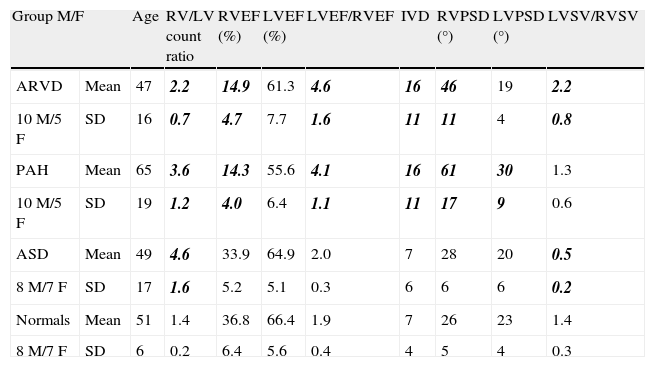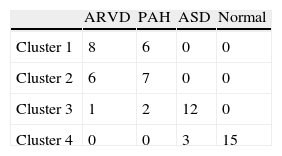Gated radionuclide ventriculography (RNV) may be used for the evaluation of the right ventricular function. However, the accuracy of the method should be clinically validated in patients suffering from diseases with specific pathology of the right ventricle (RV) and with possible left ventricular (LV) interaction.
MethodsThree groups of 15 patients each, diagnosed with arrhythmogenic right ventricular dysplasia (ARVD), pulmonary artery hypertension (PAH) or atrial septal defect (ASD) were compared to a group of normal subjects. The parameters for both ventricles were evaluated separately (ejection fractions: LVEF and RVEF, and intraventricular synchronism quantified as phase standard deviation: LVPSD and RVPSD) as well as the relation or interdependence of the right to left ventricle (RV/LV volume ratio, LV/RV ejection fraction and stroke volume ratios, and interventricular synchronism).
All the variables as a whole were analyzed to identify groups of patients according to their functional behaviour.
ResultsSignificant differences were found between the patients and control group for the RV function while the LV function remained mostly within normal limits.
When the RV function was considered, the control group and ASD patient group showed differences regarding the ARVD and PAH patients. On evaluating the RV/LV ratios, differences were found between the control group and the ASD group. In the PAH patients, LV function showed differences in relation to the rest of the groups.
ConclusionRNV is a reliable clinical tool to evaluate RV function in patients with RV abnormality.
La ventriculografía con radionúclidos (RNV) se puede utilizar para la evaluación de la función ventricular derecha, pero debe ser validada clínicamente en pacientes con patología específica del ventrículo derecho (RV) y con posible interacción del ventrículo izquierdo (LV).
MétodosTres grupos de 15 pacientes cada uno, con diagnóstico de displasia arritmogénica del ventrículo derecho (ARVD), hipertensión arterial pulmonar (PAH) o defecto del septum auricular (ASD) se comparan con un grupo de sujetos normales. Se valoran parámetros de ambos ventrículos por separado (fracción de eyección: LVEF, RVEF y sincronismo intraventricular, cuantificado como la desviación estándar de la fase: LVPSD y RVPSD) así como la relación o interdependencia del RV con el LV (RV/LV volumen, LV/RV fracción de eyección y sincronismo interventricular).
Se analizaron también todas las variables en conjunto para identificar grupos de pacientes según su comportamiento funcional.
ResultadosSe encontraron diferencias significativas entre los pacientes y el grupo control para la función del RV mientras que la del LV se mantiene dentro de los límites normales.
Cuando se considera la función del RV, el grupo control y los pacientes con ASD muestran diferencia con los pacientes ARVD y PAH. Cuando se valora la relación RV/LV hay diferencia entre el grupo control y el grupo ASD. En el grupo de PAH, la función del LV muestra diferencias con el resto de los grupos.
ConclusiónLa RNV es una herramienta clínica fiable para valorar la función del RV en pacientes con patología del RV.
Artículo

Revista Española de Medicina Nuclear e Imagen Molecular (English Edition)
Comprando el artículo el PDF del mismo podrá ser descargado
Precio 19,34 €
Comprar ahora










